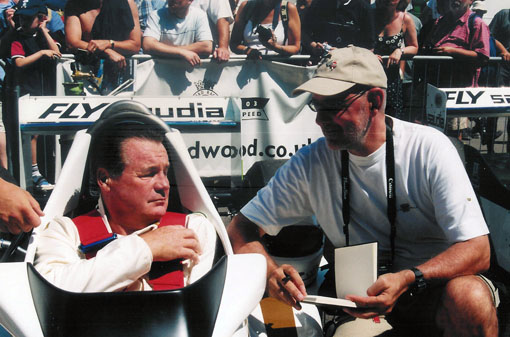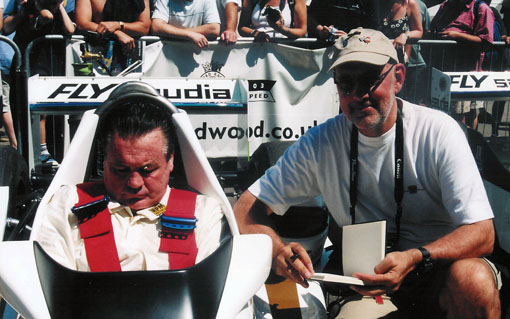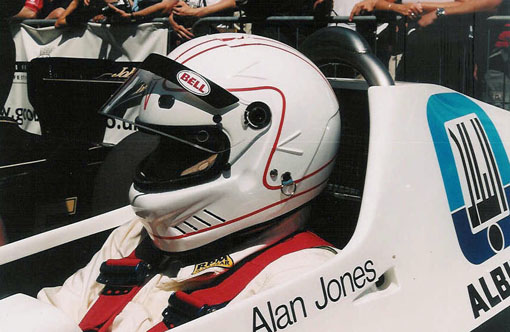

2003 FESTIVAL OF SPEED
GOODWOOD
Alan Jones, posing with my brother Luc.


The son of Australian racing hero Stan Jones, Alan grew up with racing cars all around him and not surprisingly developed the urge to become a Formula 1 driver. He raced karts in his teenage years and after he left school he went to work in his father's Holden dealership and began racing a Mini and then took over an old Cooper chassis which his father owned. Times were hard, however, and Jones Sr could not afford to fund his son's efforts and so in 1967 Jones Jr took the decision to go to Britain and try to make his way in European racing. The trip was not a success but undaunted Jones went back in 1968 and for the next four seasons wheeled and dealed to get himself a break in racing. Finally in 1973 he began to score some good results at the wheel of a GRD Formula 3 car. It was enough to convince wealthy racing enthusiast Harry Stiller that the Australian had a future and he funded a Formula Atlantic programme for Jones in Britain in 1974. He won three races and Stiller then decided to buy an old Hesketh F1 car for Jones to drive in 1975. He made his F1 debut in the non-championship International Trophy and finished seventh and then followed up with four World Championship events before Stiller shut down the team. It was fortunate for Jones that Rolf Stommelen had been hurt at the Spanish GP and he then took over the German's drive with the Embassy Hill team and he scored his first two points for fifth place in Germany. When Stommelen returned to action Jones had to make do with Formula 5000 and the death of Graham Hill that winter and the closure of the Hill team left him high and dry. John Surtees came to his rescue and showed well during 1976, collecting seven points in the World Championship. But he did not get on with Surtees and left the team at the end of the year and signed to drive for Teddy Yip in America where Yip was running a Formula 5000 team and USAC races. Fate intervened again early in 1977 when Shadow driver Tom Pryce was killed in South Africa. The team needed a replacement and approached Jones. Later that summer he scored a remarkable win in the wet Austrian GP. That was enough to convince Frank Williams that Jones was the man he needed for the newly-formed Williams Grand Prix Engineering in 1978. It was a risk for Jones but Williams had big ambitions and money from Saudia Airlines. The FW06 was a useful car and Jones scored on several occasions. That year he also raced in CanAm and won the title with a Jim Hall Lola. The 1979 season saw the arrival of Patrick Head's Williams FW07 and once the car was properly developed Jones began winning races, taking victories in Germany, Austria, Holland and Canada but still only finishing third in the World Championship. The 1980 season was to be the highlight of his career as he won five races and the World Championship (in fact he won six times but one race was later declared to have been non-championship). He might have won the title in 1981 as well but for poor reliability and an unpleasant relationship with team mate Carlos Reutemann, who chose not to obey team orders. At the end of the year Jones decided that he had had enough and at 35 decided that it was time to go back to Australia. He ended his career in Las Vegas with a dominant victory and it looked like he managed to go out on a high but in 1983 the lure of money drew him back to F1 and he raced at Long Beach for Arrows. In 1985 he agreed to join Carl Haas's team and in the course of 1986 he picked up four points but the cars were never very successful and at the end of the year he dropped out of F1 again. In the late 1980s he was a regular on the Australian Touring Car scene but then drifted into television commentary work, which he continues to do.